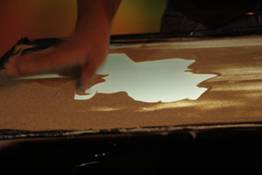

There are two types of Common Sand Animation Techniques :
• Pouring Techniques
• Manipulation Techniques
Pouring Techniques:
Pouring is an additive technique that varies depending on how much of the canvas is affected. Canvas pouring is used to set the texture and initial context for painting (Fig. 2 left), or, to change context while storytelling. Skinny pouring is used to draw tiny details, lines, and shape (Fig. 2 right).


Fig 2: Canvas pouring (left) creates background textures, while skinny pouring (right) is for drawing lines.
Manipulation Techniques:
Sand manipulation techniques move sand rather than adding it. Fingertip drawing traces out lines with the tip of one or more fingers. While, finger carving uses the whole finger - index finger, small finger or thumb, for drawing and fine tuning shapes.


Fig. 3: Fingertip drawing (left) and finger carving (right) to create and manipulate shapes.
• Palm rubbing: Palms are often used to create circular or spiral like patterns.
• Hand sweeping: Whole hands are often used to make big sweeps to clear the canvas and set up a new stage for the animation.


Fig. 4: A palm rub (left) draws patterns, and a Hand sweep (right) clears part of canvas.
Sand animators also use both hands simultaneously to quickly draw or pour symmetrical patterns in sand.

Fig. 5: Symmetrical hand sweep (left)

Fig. 6: Fluid transformation of images.